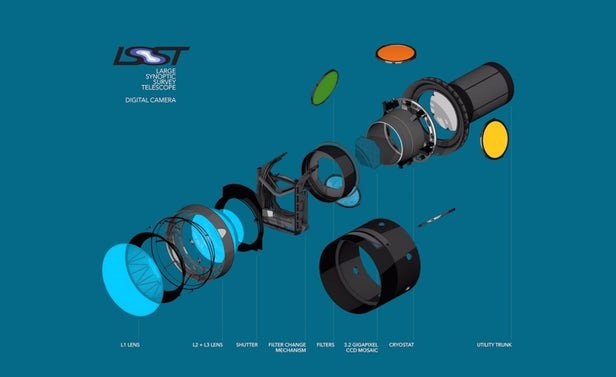World's most powerful digital camera gets the go-ahead

Rendering of the LSST camera, which will be the size of a small car and weigh more than 3 tons
A smartphone with a 16-megapixel camera may seem cutting edge, but it won't impress astronomers now that the US Department of Energy's SLAC National Accelerator Laboratory has given the green light to start construction of the world's largest digital camera. With a resolution of 3.2-gigapixels (enough to need 1,500 high-definition television screens to display one image), the new camera is at the heart of the 8.4-meter (27.5-ft) Large Synoptic Survey Telescope (LSST) now under construction atop Cerro Pachón in Chile.
Not surprisingly, the new camera is no lightweight. The three-mirrored device is the size of a small car, tipping the scales at over 3 tons (2.7 tonnes). It's the result of a wide partnership of institutions that include Brookhaven National Laboratory, Lawrence Livermore National Laboratory, and SLAC, contains 189 sensors, has a resolution equivalent to 800,000 eight-megapixel cameras, and includes a filter-changing mechanism and shutter for viewing different wavelengths from the near-ultraviolet to the near-infrared.
Having passed Critical Decision 3, the last major approval decision, the camera will be built and tested over the next five years in a new 185-sq m (2,000-sq ft), two-story-tall clean room at SLAC in Menlo Park, California before being installed in the LSST.

In 2022, the camera and the LSST will begin a 10-year mission to take digital images of the entire Southern sky every few nights as part of a program to catalog the largest number of visible stars and galaxies yet, which is expected to generate about six million gigabytes of data per year. It's hoped that this will help astronomers to gain a better understanding of galaxy formations, aid in tracking potentially dangerous asteroids, and provide a better understanding of dark matter and dark energy, which is believed to make up 95 percent of the Universe.
"We’ve been working hard for years to get to this point,” said Nadine Kurita, camera project manager at SLAC. "Everyone is very excited to start building the camera and take a big step toward conducting a deep survey of the Southern night sky."
Congratulations @iaslam70! You have completed some achievement on Steemit and have been rewarded with new badge(s) :
Click on any badge to view your own Board of Honor on SteemitBoard.
For more information about SteemitBoard, click here
If you no longer want to receive notifications, reply to this comment with the word
STOP